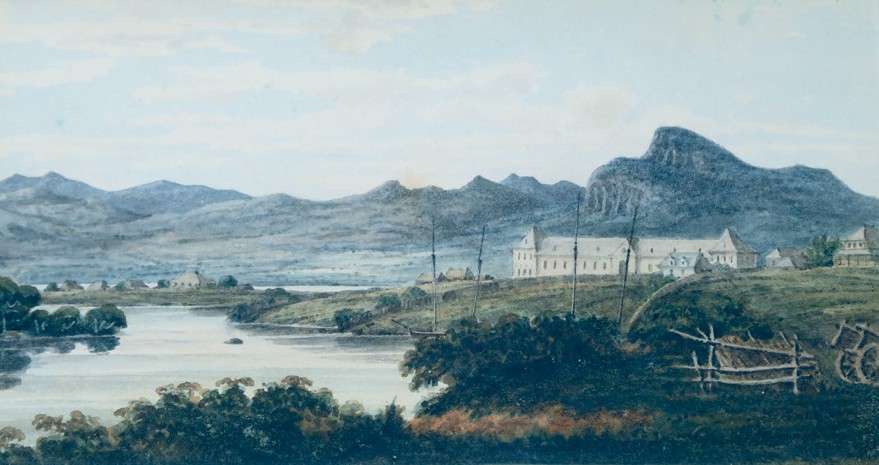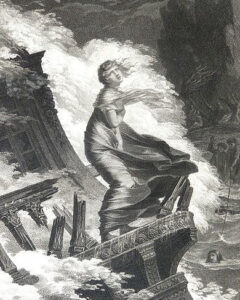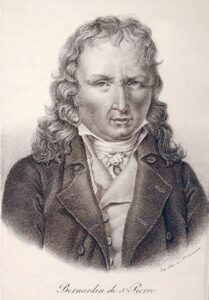Jean Toussaint Jocet de la Porte (c.1692 -1780)
The Royal Philippe, November 1728
Jeanne Thérèse Deschallets, the wife of Jean Toussaint Jocet de la Porte, set foot on the Isle de France on the morning of April 29th, 1729. She would never know it, but she and her husband were to be at the origin of the Mauritian branch of the de Chazal family. Consequently, she became the first woman, by blood relation, to have seen the bay dominated by Lion Mountain in the southeast of the island.
It was on the sailing ship Royal Philippe which left Lorient on 24 November 1728 for Cadiz, Spain, the Mascarene islands and India, that Jeanne Thérèse would suffer the five toughest months of her life. Indeed, the vessels of the East India Company, built to the same standards as those of Colbert in the century before, offered rudimentary comfort for those undergoing long voyages.
Space was cramped, privacy infrequent, conditions of personal and food hygiene almost nonexistent. In the vicinity of hot countries, drinking water was kept in barrels and turned yellow, then black. Contaminated water and the serving of meat that had gone off, mainly salted beef and pork, were factors that caused dysentery. Despite the sailing experience of thirty-three-year-old Captain Marc-Auguste Baudran de la Mettrie mortality from accidents at sea as well as disease remained high; the voyage was still plagued by the usual deaths due mainly to scurvy, but also to the fevers that bedevilled sailing vessels at that time.
Fortunately, Jeanne Thérèse was not alone in undertaking that long journey fraught with constant and multiple perils. She was accompanied by her husband Jean Toussaint Jocet de la Porte and their two children, a son named Jean Toussaint and daughter Renée Perrine, aged five and three respectively. Not wanting to leave her mother alone in Saint Malo she also had her, Jacquette Heuzé, making up the family group.
She was aware that the experience of her husband, a man hardened by the sea and aware of all the risks involved, had certainly saved their life, as he was attentive to the smallest detail to protect his family and tried to keep them from disease. He had been sailing since adolescence and had to his credit a distinguished record of voyages in the Merchant Navy, including one from 1721 to 1723 on the Centaure to South America, as second navigator, going from Saint Malo to Brazil, Peru and back to Lorient. He then sailed twice to the Mascarene islands and India: as first navigator on the Duc de Chartres in 1724-1726 and as his desire to see the Mascarene islands again was so strong he went as a simple sailor on the Lys in 1727-1728.
Jean Toussaint was familiar with the two islands of Bourbon and the Isle de France on the way to India. It was during his trip on the Duc de Chartres that he first entered the huge south-eastern bay of the Isle de France on 26 August 1724. The surroundings were enchanting, chosen by the Dutch for an attempt at settlement from 1638 to 1710. Owing to adverse winds, the Captain was forced to stay more time than planned, so Jean Toussaint took the opportunity to explore the island for nearly five weeks, following a few scattered trails. French colonization had not yet been seriously promoted. He discovered some houses with roofs covered in thatch made from palm leaves, housing twenty poor settlers from Bourbon and a handful of employees of the Company, cabins of basic construction housing forty Malagasy slaves and barracks housing a hundred soldiers. The promise of concessions to cultivate land had not attracted any success. He then had the opportunity to explore the island further, particularly the coastal areas, during his visit on the Lys, in 1727-1728.

“The Barracks of Mahébourg”. Based on a watercolor by W. S. Streatfield made around 1820.
Collection : Mauritius Institute
Jean Toussaint and Jeanne Thérèse, both residents of Saint Malo, were married in Saint Malo Cathedral, on 24 September 1720. Like many seamen from Saint Malo, Jean Toussaint was often absent from home. He was separated for four out of eight years of marriage; four years sailing on the ships of the French East India Company merchant fleet. A trading trip to India would require him to be away for a year and a half. Jeanne Thérèse struggled to live through those long absences, and could not resign herself to the lack of news during those periods of uncertainty knowing as she did that those trips could result in death. Jean Toussaint, seduced by life in the tropics, suggested that they all live together in that region of the world. The Compagnie des Indes, in favour of settlements on the island, offered them that possibility by offering him a position as a pilot in Mauritius as well as paying for his transportation and that of his family including that of his mother-in-law. It was a deal they could not refuse, even if they would not be eating at the officers’ table.
The Isle de France revealed itself like an oasis to the Royal Philippe passengers exhausted by a long, gruelling and deadly journey from Lorient. They would be able to recuperate in that tropical land, where the water in the streams was clear and refreshing. As well as the Jocet family, about 30 passengers landed on the Isle de France, all eager to settle there, while 15 other travellers would make their lives in Bourbon. About 40 soldiers were divided between the sister islands. The 162 crew members who had sailed from Lorient, reduced by deaths and the diseased left ashore, would continue to sail on the waters of the Indian Ocean to Pondicherry, located on the coast of Coromandel in India.
To be on dry land after five months confined to the ship was a relief for the members of the family, but their challenging times were not over, despite the fact that Jean Toussaint had taken up the coastal pilot position for which he had been hired. Their arrival in the island coincided with a period of scarcity; crops had been damaged by locusts, introduced in the soil of plants from Madagascar, and were not sufficient for local consumption. Cyclones and disease aggravated the situation of utter loss. The appalling living conditions on the island had a part in a high rate of infant mortality. This real carnage of children who were already scarce on the island which was made worse by the lack of women. Deaths followed births. The Jocets’ third child, a girl, died 15 days after her birth on 12 June 1730. The young Jean Toussaint, who had survived the journey on the Royal Philippe, died on 21 February 1733 at the age of 9 years. Renée Perrine, another survivor of the long journey, died in 1735, much to the despair of her parents. Six of their 14 children would die young.
The Jocets began to regain hope in 1735, with the arrival of a providential man, Captain Mahé de La Bourdonnais, from Saint Malo like themselves, who was appointed Governor of the Isles de France and Bourbon and whom they knew had the determination and competence to be an effective administrator. Their hopes of salvation were becoming a reality. That ambitious reformer would transform the Isle de France. Port Nord-Ouest became Port Louis, port activity intensified in a significant way to the satisfaction of Jean Toussaint, now an experienced pilot in island navigation. With the frequent stopovers of vessels on their way to India, arriving to buy fresh vegetables and drinking water, or undertake necessary repairs, he was able to revel in the atmosphere of the sea voyages that had been his world since his days as a ship’s boy at the age of 12.
After all that hardship, when their daughter Jeanne Thérèse Félicité was two years old, the Jocet family, to their delight, obtained a concession of 294 acres along the Tombeau river. For the time being they only had the use of it, new concessions being granted after much difficulty, and dependent on the willingness of the applicants to settle on the island and their positive financial prospects. The family as a tenant for life would have to pay substantial fees to the Compagnie des Indes without any certainty of obtaining the title deeds in the near future.
In 1738, a new ordeal was to spoil the happiness of Jeanne Thérèse and Jean Toussaint Jocet that they had regained in some measure. Brigitte, their daughter, hardly one-year-old, died of a childhood illness. Almost simultaneously, a few weeks apart, the family of Mahé de La Bourdonnais was decimated. The Governor lost his wife and two of his children. Despite having faced the loss of countless lives on the ships of the Compagnie des Indes, both men were terribly affected by the death of their loved ones. Nevertheless, they found the necessary strength to continue the mission entrusted to them with zeal. La Bourdonnais was on the road to his destiny as builder of the Isle de France, while Jean Toussaint’s dreams, that had so often come to nothing, began to materialize.
The Saint-Géran, March 1744
The tragic news spread like wildfire among the inhabitants. Near Poudre d’Or, soldiers on patrol had found as, if from another world, nine wounded men, haggard and staggering. They were survivors of the sinking of the merchant ship Saint-Géran, which had had nearly 200 people on board. The population was overcome with a strong emotion unaccustomed as it was to such a tragic situation. The Governor, Mahé de La Bourdonnais, as soon as he knew, immediately took measures to send a few men to the possible scene of the disaster. Among those were probably Jean Toussaint, who had had the most training in coastal navigation and who that same year had been made port sub-lieutenant. But on the third day of the drama nothing remained, not a trace. No other survivor was found.
A succession of navigational errors made on approaching the coast had guided the ship onto the coral reef on 18 August 1744 at about 3 a.m. Despite desperate attempts to save it, the vessel broke up, the passengers and crew were forced to abandon ship by swimming or using a plank. Eleven men and a female slave who had embarked at the island of Gorée, managed to reach the neighboring Amber island, two kilometers away, by swimming along the edge of the venomously sharp coral reef; three of them, including the woman, died shortly after their arrival from their wounds and exhaustion. Those who chose to swim the four kilometers from the reef to the shore did not survive.
For several weeks the nine survivors appeared before the Superior Council while the notary Jean Molère, a close acquaintance of Jean Toussaint, acting as clerk, recorded their statements. That human disaster prayed on people’s minds. No doubt the people, curious to know a little more about the circumstances of the tragedy, and to meet those who had been miraculously saved, welcomed them with warmth and extreme kindness. It is likely that Jean Toussaint, following the solidarity of seafarers, might have obtained additional unpublished details of that long five-month voyage and its outcome.
Over time Jean Toussaint forged close ties with some of his former travelling companions who had arrived at Isle de France 15 years earlier on the Royal Philippe. Among them was Madame de St-Rémy, the aunt of Marie-Anne Mallet; the latter, an elegant Parisian of 20 years, was going to meet her mother who had left for Isle de France in 1730 with her late father Guillaume Mallet.
Another traveler on the Royal Philippe, who remained close to Jean Toussaint, was Hélène Dumanche. Her 11-year-old daughter, Jeanne, whose father was a soldier named Neizet or Neizein who had died before her birth, had disappeared when the Saint-Géran sank, along with her chaperone the engineer Belval, devoted admirer of her mother. Another well-known familiar face on the Royal Philippe, sublieutenant Jean-François Malles, who had been promoted to first lieutenant, was also on that fateful journey.
Jean Toussaint, because of the nature of his work, his acquaintances within the maritime world and his privileged position in relation to the notary François Molière, who had transcribed the witness statements of the nine miraculous survivors, and who had drawn up the marriage contracts for his daughters, was certainly the islander who knew the most about the Saint-Géran disaster.
Bernardin de Saint-Pierre, (French Writer)
On 13 July 1768 the Marquis de Castries made a stopover at the Isle de France. On board was the Marquis de Maudave, en route to Fort Dauphin, Madagascar, who was to make another attempt to set up a trading post on that large neighboring island. Bernardin de Saint-Pierre, who was involved in the development of the project as an engineer, disembarked in Port Louis due to mutual incompatibility with his superior, the aforementioned Marquis.
Thirty-one years old, attractive, educated and with a way with words, Bernardin de Saint-Pierre was very well received during his two-year stay on the island. He had an enquiring mind and enjoyed meeting people and dining with the settlers.
Twenty-five years had passed since the sinking of the Saint-Géran. The population kept the memory of it alive. Jean Toussaint, who knew every detail of the tragedy, but was a modest man, was no doubt persuaded to tell stories about it and praise the attractive Marie-Anne Mallet, his heroine. Perhaps in memory of her father, Jacques Guillaume Mallet, with whom he witnessed and cosigned the death certificate of a certain Madame Pierre Lefébure, in 1733.
Jean Toussaint was seventy-nine years old when Bernardin de Saint-Pierre was on the island. How could the writer who was always so attentive, and a friend of his son-in-law François de Chazal de la Génesté, not have heard, or listened more carefully to the stories told of the event, especially since the concession that Jean Toussaint now fully owned was close to that of Pamplemousses where his daughter Jeanne Thérèse Félicitée and his son-in-law François lived?
The famous novel by Bernardin de Saint-Pierre, Paul and Virginie was published in 1788, eight years after the death of Jean Toussaint at the age of 88. In the book the old man in the woods, on the banks of the river that flowed along Montagne Longue, could be none other, according to the Mauritian historian Philippe Koenig, than the former sailor from Saint Malo; and why not, Virginie the unfortunate Anne-Marie Mallet ?
Text : Jean-Pierre de Chazal
English Translation : Christopher de Chazal, reviewed by : Miranda Patel and Miriam Jamet



Leave A Comment
You must be logged in to post a comment.